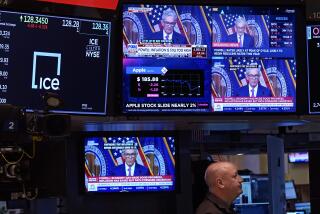Money Supply Up $2.8 Billion
- Share via
NEW YORK — The nation’s basic money supply rose $2.8 billion in the latest reporting week, the Federal Reserve Board said Friday. The big increase in the money circulating through the economy slightly exceeded analysts’ expectations.
The Fed said M1 rose to a seasonally adjusted $616.6 billion in the week ended Nov. 18 from a revised $613.8 billion in the previous week. M1 for the week ended Nov. 11 had originally been reported as $613.6 billion.
M1 includes cash in circulation, deposits in checking accounts and non-bank travelers checks.
The increase left the money supply $9.8 billion above the upper limit of the Federal Reserve’s target range for growth in the money supply. The Fed has said it would like to see M1 grow between 3% and 8% in the second half of 1985 in order to promote non-inflationary growth.
For the latest 13 weeks, M1 averaged $611.7 billion, an 11.4% seasonally adjusted annual rate of gain from the previous 13 weeks.
Analysts said the latest jump was not of great importance because the Fed has paid less attention to fluctuations in M1 in recent months. However, they said it might increase the Fed’s worries about the possibility of renewed inflation and decrease the chance that the Fed would cut the discount rate, which is the interest fee that it charges on loans to banks and savings institutions.
Thomas Thomson, chief economist at Crocker National Bank in San Francisco, said the big jump in the money supply strengthened his conviction that the Fed will not cut the discount rate. He said he thinks the next move will be an increase in the rate, probably next spring or later.
Thomson said he thinks bond traders are mistaken if they are bidding up prices on the expectation of a discount-rate cut.
“Rallies do take on a life of their own,” he said. “You get a good rally going on and you get portfolio managers concerned that they might have to show cash in their quarterly report while the rally was going on,” indicating that they missed the boat.
W. Lee Hoskins, senior vice president and chief economist for PNC Financial Corp. in Pittsburgh, said he doubted that the Fed would cut the discount rate until it saw employment figures and a recalculation of the gross national product due out in December.
He predicted that the economy would expand at an annual rate of about 4% over the next nine months, which he said would put upward pressure on interest rates.
In other reports:
- The Federal Reserve Bank of New York reported that commercial and industrial loans at major New York City banks fell $270 million in the week ended Nov. 20, compared to a decline of $517 million a week earlier.
- The Federal Reserve said that the federal funds rate--the interest rate on short-term loans between banks--averaged 7.71% in the week ended Wednesday, down from 8.13% in the previous week. It was the lowest weekly average since the week of July 31, a Fed spokesman said.
- The Federal Reserve said bank borrowings from the Federal Reserve System averaged $3.767 billion, up from $1.055 billion. The average included a record loan of more than $20 billion that the Fed said was associated with clearing problems at a New York bank that it did not name. The Bank of New York, the nation’s largest clearer of government securities, had a computer problem last week that forced it to borrow money from the Fed.
- The Federal Reserve Bank of St. Louis reported that the monetary base--the seasonally adjusted total of member bank reserves held at Federal Reserve banks and cash in bank vaults and in circulation--was $233.4 billion in the week ended Wednesday, up from a revised $230.4 billion a week earlier. The figure for a week earlier had been reported as $230.6 billion.
More to Read
Inside the business of entertainment
The Wide Shot brings you news, analysis and insights on everything from streaming wars to production — and what it all means for the future.
You may occasionally receive promotional content from the Los Angeles Times.










